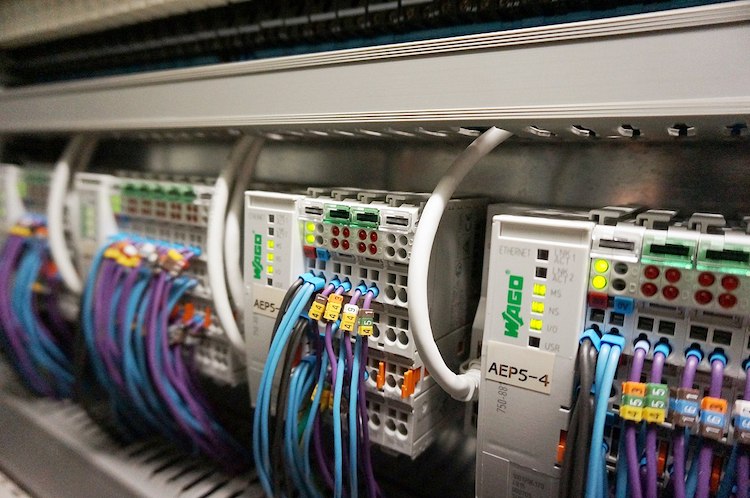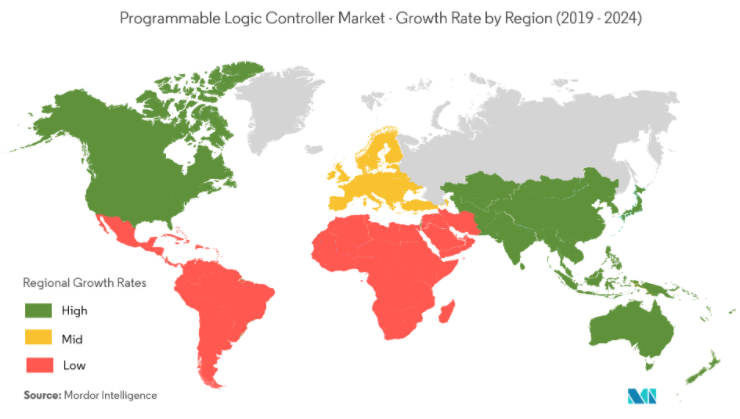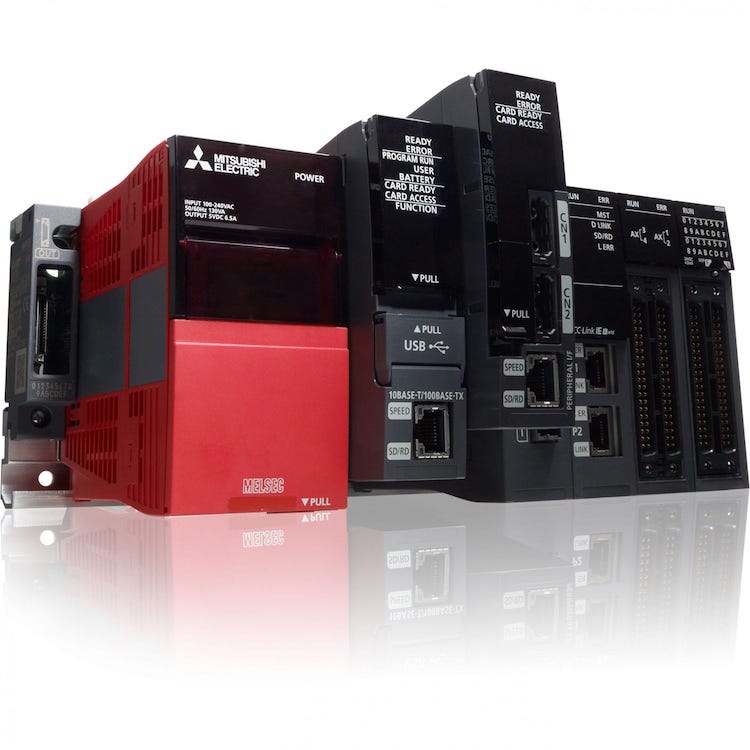Top 20 programmable logic controller manufacturers
Sometimes described as “the workhorse of industrial automation”, a programmable logic controller, or PLC, is a computing device that is specially designed for use in an industrial operation.
A PLC can take many shapes and sizes, but in most instances it does not look like a conventional desktop computer like the ones you find in offices or in homes – a PLC has no display screen, no hard drive, and no keyboard.
PLCs started out in the automotive manufacturing trade, although they can now be found in almost all sectors, where they tend to replace relays.
Relays are devices that essentially turn machines on and off, and are said to be time-consuming and complex to use compared to PLCs. Relays also require more operational downtime when they need to be reconfigured. PLCs are estimated by one research company to reduce downtime from 20 percent to about 4 percent.
Moreover, panels of relay switches generally took up a lot more space than a programmable logic controller, and they used up more electrical power, and generated more heat and soot.
And although most of the time a programmable logic controller is about the size and approximate shape of a tablet computer, it is extensively ruggedised, which often makes it look like an iPad’s very rough cousin who has grown up in a brutal neighbourhood and town, and been in a lot of scraps.

The process of “ruggedisation” means that the PLC has been built using materials and components that are harder-wearing, longer-lasting and capable of operating in what are sometimes described as “harsh environments”.
Harsh environments is generally understood to mean locations where there are strong vibrations, extreme temperatures and dirty and dusty atmospheres.
In other words, PLCs are often attached to large, industrial machines.
Generally speaking, a PLC is used to control manufacturing processes such as automated assembly lines and robotic processes.
Technical shallow-dive
Although we can’t go too deep into the inner workings of a PLC, the high-level overview is that they generally comprise a central processing unit (CPU) module, a number of input-output (I/O) devices, which are sometimes part of the CPU or in other modules.
The CPU communicates with the I/O – both generally within the same casing – which is connected to the electrical power source and the machines the PLC runs. Sometimes the CPU is some distance away from the I/O, and they are connected by a twisted pair or fiberoptic cables – an industrial internet of things, if you will, or IIoT.
The PLC can integrate digital as well as analogue inputs and outputs.
Most PLCs are programmed using software applications that run on conventional laptop or desktop computers, which communicate using Ethernet, USB or some proprietary data communication system.
The specifics in this area – languages, processes, capabilities, and so on – is diverse and manufacturers have not agreed many standards that would make programming PLCs what you might call “open” or inter-operable, or platform-agnostic.
The American National Standards Institute introduced a standard – the IEC 61131-3: 2013 – some years ago to encourage more co-operation, but it’s a hugely competitive sector which is seeing massive growth at the moment, so it’s unlikely to happen anytime soon.
A fast-growing market
According to research by Mordor Intelligence, the PLC market was worth almost $4 billion ($3,897.36 million, says Mordor) in 2019.
It is expected to reach $4.3 billion ($4,292.66 million) by 2025, at an annual growth rate of 3.7 percent over Mordor’s forecast period of 2020-2025.
A large portion of the growth is expected to come from the automotive manufacturing sector, where PLCs first emerged, and the sector that uses more industrial robots than any other.
In terms of geographical regions, Mordor estimates that the US is likely to see the strongest growth in demand for PLCs because of the increased emphasis by the government on manufacturing, as well as the rise in investment in the mining and oil and gas sectors.
The US is included with Canada as a region that will see what Mordor says will be “high growth” in demand for PLCs. The other countries that will high growth include:
- China;
- India;
- Australia; and
- Japan.
Europe is regarded by Mordor to have mid-level prospects for growth, partly because it is already an advanced industrial region and is home to many of the largest manufacturing nations in the world.

Just make the list already
Having reached the limit of our technical knowledge about PLCs, it’s time to just make a list of what our research has found to be the top 20 PLC manufacturers.
But we should caution that while we feel confident that we have listed the top 20, we cannot say that the order of that top 20 is rigorously scientific.
The criteria we used includes sales, adoption, market share, awareness levels, discoverability online, and so on – whatever we could find. Journalism is more of an art than a science anyway. That’s our excuse.
Having said that, we have done our best to highlight the main companies and the essence of their offerings, as well as some pertinent details – at least some of which, we hope, you will find useful.
If you have any suggestions or information that may strengthen this article, please feel free to email us and contribute your knowledge in what is a fundamental technology in industrial automation.
So, here’s the list, below.

Top 20 programmable logic controller manufacturers
1. Siemens
Estimated by some to be the clear leader in PLCs, Siemens has approximately 30 to 40 per cent market share, depending on which report you believe, although these estimates are based on aggregating the top 10 or so, which together are said to sell far more of the devices than all the rest put together.
Europe’s largest engineering company, with a market capitalisation of almost $124 billion and revenues of $60 billion a year, German giant Siemens says its SIMATIC range has a controller “for every application”.
2. Rockwell Automation / Allen Bradley
Rockwell Automation acquired Allen Bradley for approximately $1.6 billion in 1985. It was a lot of money back then, and it would be a lot of money now. But the value of Allen Bradley is raised by the fact that it is a historic brand founded in 1903, the same year as Rockwell.
In fact, the two American firms have always been somewhat intertwined and followed the same path on their journey to become what is now, as a combined unit, one of the world’s largest industrial automation companies.
Its PLC offerings range from large down to tiny “nano” systems. Its market capitalisation is $25 billion and its annual revenues around $7 billion.
With a market cap of around $28 billion, Mitsubishi Electric is one of the larger business units of the gigantic conglomerate that is the Mitsubishi Group, with a staggering 350,000 employees.
In 2017, Mitsubishi Electric’s annual revenue was $37 billion, which is obviously more than its current market cap, so there have been ups and downs.
Nonetheless, it is one of the largest manufacturers of PLCs, with arguably the widest range, and its Japan headquarters are in a region where fast growth is predicted.
Arguably not as well known outside of the industrial sector as others in this list, partly because it doesn’t have any consumer products of note, Schneider Electric is nonetheless a leading provider of PLCs.
Modicon, one of Schneider Electric’s brands, is believed to have produced the first PLC in the US back in 1968. Then, through a series of mergers and acquisitions, Schneider Electric emerged in 1999.
Today, Schneider Electric – a French company – employs 135,000 people, has a market cap of around $55 billion, and generates annual revenues of more than €27 billion.
5. ABB
The Swiss-Swedish industrial giant has enjoyed spectacular success in recent years, at least in terms of the flair with which it has launched many new products – from what it describes as “the world’s first truly collaborative robot”, the two-armed YuMi, to its industrial internet of things platform, Ability.
And its $50 billion market cap, $28 billion annual revenues, and 144,000 employees, shows that there’s plenty of substance behind the style.
ABB is also one of the world’s largest manufacturers of industrial robots, so it follows that it has a wide range of PLCs on offer.
Honeywell Process is one of the business units of Honeywell International, which started in some form back in 1906.
The parent company, headquartered in the US, employs 114,000 people, has annual revenues of almost $42 billion, and a market cap of more than $103 billion.
Honeywell considers itself a cutting-edge computing company and is currently competing with Google and IBM in the field of quantum computing.
The PLCs Honeywell Process currently offers are within its ControlEdge range, a name which suggests that the company prioritises edge computing over cloud computing, something that may reassure industrial companies, many of which are paranoid about allowing any data to go beyond its facilities.
7. Omron
This Japanese company often launches hundreds of products in one go, and is something of a specialist in PLCs, although it has quite a wide range of offerings, including industrial robots and sensors.
Omron’s PLC range includes micro as well as modular versions and, all told, it has probably has the highest number of individual devices.
The company, which was founded in 1933, employs almost 40,000 people and has a market capitalisation of approximately $14 billion, with annual revenues of more than $8 billion.
8. Hitachi Industrial Equipment Systems
Hitachi used to be globally famous back in the day when we were all carrying boom boxes around on one of our shoulders, playing Fight the Power way too loud, occasionally putting it down to do some breakdancing.
But these days, Hitachi mostly confines itself to the industrial sector, where it has developed many advanced computing technologies, although it still does a nice line in smart televisions. Its PLCs range from general purpose ones to more specialised, ultra-fast versions designed for plant engineering.
Still a giant with a $36 billion market cap, Hitachi employs significantly more than 300,000 people and generates annual revenues of almost $90 billion a year. Note that the coronavirus pandemic may be the reason for the market cap currently being significantly lower than its annual revenue for 2019.
9. IDEC
Compared to some of the global giants on this list, IDEC is a small company with a market capitalisation of $523 million, and annual revenues of around $500 million.
The Japanese PLC specialist is a strong supporter of Ethernet as a networking method and its devices are accessible through conventional browsers.
This means that many of IDEC’s customers use it for remote monitoring of machinery, and its MicroSmart Pentra PLC enables them to monitor status in real-time, receive email alerts and customise their own web pages.
This relatively young Austrian company, founded in 1979, has been operating very successfully throughout its history, with 190 offices in 68 countries at last count.
Its annual revenue for 2016 was €620 million and its employee count stood at 3,000. Those are the last figures available for B&R Industrial Automation as an independent company because ABB acquired the company the following year for an undisclosed sum.
B&R offers a wide range of industrial automation products including PLCs, which it says have unique features such as I/O “slice” system design and “the highest degree of freedom for decentralized machine and system concepts”.
11. Bosch Rexroth
Bosch is probably the most famous name on this list, being as it is one of the world’s leading suppliers of home appliances such as washing machines, fridges and whatnot.
The automation technology business unit of Bosch merged with Mannesmann Rexroth in 2001. Hence Bosch Rexroth, which has more than 33,000 employees and has annual revenues in the region of €5.5 billion.
Its PLC range includes Windows-based, IoT-enabled systems with modular options, and features things like Ethernet-based real-time communication with the automation bus Sercos as well as synchronized motion control functionality.
12. Koyo Electronics Industries
This Japanese company was established in 1955, having started out making radios, and now specialises in industrial automation technology, such as PLCs and other electronic control devices as well as imaging and automotive systems.
Its Direct Logic brand of PLCs sits alongside other brands such as its Kostac PLC, and make for a relatively wide range of products for the market.
The market capitalisation of its parent company, JTEKT, is in the region of $2.7 billion. JTEKT, in turn, is owned by Toyota.
13. Delta
The sheer breadth of this Taiwanese company’s activities is quite impressive, stretching from industrial robots to smart buildings, much of which requires PLCs for their smooth operation.
Consistent with its diverse activities, the PLCs it offers are many and varied, and include modular systems as well ones which are “hot swappable”, which means they can be replaced without halting the entire operation.
Its market capitalisation currently stands are more than $16 billion, and it employs more than 83,000 people, who generate annual revenues of around $9 billion.
14. Eaton
Another one of those venerable names in the industrial sector, Eaton was established way back in 1911. Today, it employs more than 100,000 people and has annual revenues of around $21 billion. Its market cap is currently almost $37 billion.
Eaton’s business units cover aerospace, automotive, and of course the industrial sector, where perhaps it is best known for hydraulics, clutches and transmission systems.
Eaton emphasises user-friendliness with its PLCs, with its Easy PLC range, as well as the modular capabilities of XC and XN devices.
15. Keyence
Another Japanese industrial automation specialist, Keyence is an amalgam of 16 organisations, all of which supply products in the same sector, from sensors and lasers to micrometers and microscopes.
In the PLC segment, the company offers compact as well as modular types within its KV range.
The company employs about 6,600 people, has annual revenues of almost $5 billion, and a market cap of more than $100 million.
16. LS Electric
LS Electric is spin-out from South Korean conglomerate LG Electronics. It employs about 3,500 people and annual sales revenues of about $2 billion. Its market cap is approximately $1.4 billion.
The company offers a wide range of PLCs, with LG Electronics likely its biggest customer. Among its range is a specialised motion and positioning module.
17. Panasonic
Panasonic used to be a massive consumer electronics company but hasn’t been as prominent in the desktop and mobile computing eras.
It still does a nice line in TVs and has a strong presence in the industrial sector, where it offers an extensive range of PLCs, from entry level, compact devices to high-powered modular and scalable versions.
The company employs a massive 270,000 people who generate annual revenues of $75 billion. Its market cap is in excess of $23 billion.
18. Phoenix Contact
Compared its German compatriot companies, Phoenix Contact is a small company, employing about 16,000 people. But that relatively small number of employees generate a massive revenue of about €2.3 billion a year.
Many German companies in the industrial sector are privately held, and Phoenix Contact may be one of them, since we can’t seem to find any listing of them on any stock exchange.
Its product range is highly diverse and extensive, considering its size, and it offers different types of PLCs, some specialised for building infrastructure, others conventional, and one called PLCnext Control, designed for industrial automation operations.
19. Pilz
Another relatively small, or even smaller, German company, Pilz specialises in industrial control systems, which include PLCs.
It employs 2,300 people and generates annual revenues in the region of €340 million through some 40 subsidiaries.
Another company which could be privately held since we can’t find it stock exchanges, Pilz offers a range of aesthetically pleasing “PSSuniversal” PLCs for “interlinked, complex plants”.
With sales of about $1 billion a year, this apparently privately held German company is something of a giant in the PLC market, even with a relatively small number of employees at 8,500.
The company has developed a number of innovative technologies in different fields, and its PLCs certainly look different from those offered by other companies.
The PLCs that WAGO offers tend to be high-end customers since they are described as having been designed for “maximum performance in extreme environments”.
Another rather large Japanese industrial company specialising in electrical engineering and software, Yokogawa Electric employs 18,000 people who generate $3.7 billion in annual revenues to produce a market capitalisation of approximately $4.3 billion.
Interestingly, it appears to only have one type of PLC, the FA-M3 range, which is described as being “ultra high speed” and “stable”.
22. Toshiba
Still a household name, although another Japanese company which couldn’t keep up with the desktop and mobile computer market, Toshiba is nonetheless providing the industrial sector with a wide range of technologies, including robotics.
Toshiba offers PLCs mainly in the micro segment, but says they are capable of simple sequence control to large process and automation systems.
The company, established in 1939, currently employs more than 140,000 people and generates annual revenues in the range of $35 billion, and has a market cap of $15 billion.

